Physics-topic 8 Waves and particle nature of light
1/54
There's no tags or description
Looks like no tags are added yet.
Name | Mastery | Learn | Test | Matching | Spaced |
|---|
No study sessions yet.
55 Terms
Amplitude
A wave’s maximum displacement from the equilibrium position
Frequency (f)
the number of complete oscillations passing through a point per second
Period (T)
the time taken for one full oscillations
Speed (v)
The distance travelled by the wave per unit time
Wavelength
The length of one whole oscillation (e.g. the distance between successive peaks/troughs).
Wave speed equation
v=flambda
Longitudinal wave
the oscillation of particles is parallel to the direction of energy transfer
These are made up of compressions and rarefactions and can’t travel in a vacuum
Sound is a example of a longitudinal wave, and they can be demonstrated by pushing a slinky horizontally
Longitudinal wave picture
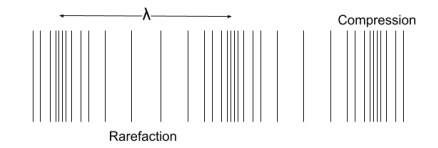
Transverse wave
the oscillations of particles (or fields) is at right angles to the direction of energy transfer
All electromagnetic waves are transverse and travel at 3 c 10^8 m/s in a vacuum.
Transverse waves can be demonstrated by shaking a slinky vertically or through the waves seen on a string, when it’s attached to a signal generator
Transverse waves picture

Displacement-distance graphs
these show how the displacement of a particle varies with the distance of wave travel and can be used to measure wavelength

Displacement-time graphs
these show how the displacement of a particle varies with time and can be used to measure the period of a wave

Phase
The position of a certain point on a wave cycle. This can be measured in radians, degrees of fractions of a cycle
Phase difference
How much a particle/wave lags behind another particle/wave. This can be measured in radians , degrees or fractions of a cycle
Path difference
The difference in the distance travelled by two waves
Superposition
Where the displacements of two waves are combined as they pass each other, the resultant displacement is the vector sum of each wave’s displacement
Coherance
A coherant light source has the same frequency and wavelength and a fixed phase difference
Wavefront
a surface which is used to represent the points of a wave which have the same phase
Wavefront example
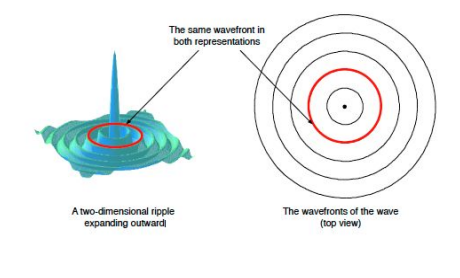
Constructive interference
this occurs when two waves are in phase and so their displacements are added (occurs during superposition)
Destructive interference
this occurs when the waves are completely our of phase and so their displacements are subtracted (occurs during superpositions)
Constructive interference picture
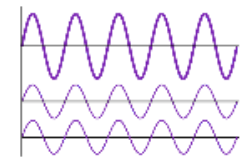
Destructive interference picture
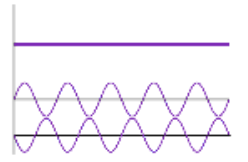
In phase
Two waves are in phase if they are both at the same point of the wave cycle, meaning they have the same frequency and wavelength and their phase difference is an integer multiple of 360 degrees.
completely out of phase
Two waves are completely out of phase when they have the same frequency and wavelength and their phase difference is an odd integer multiple of 180 degrees
phase difference equation
change in x /(lambda/2pie)change in phase difference where x is path difference
Stationary wave
formed from the superposition of 2 progressive waves, travelling in opposite directoins in the same plane, with the same frequency, wavelength and amplitude
Is energy transferred by a stationary wave?
No
Where waves meet: in phase
constructive interference occurs so antinodes are formed, which are regions of maximum displacement
Where waves meet: completely out of phase
destructive interference occurs and nodes are formed, which are regions of no displacement
Example of how a stationary wave is formed?
A string fixed at one end; and fixed to a drving oscillator at the other gives a good example of the formation of a stationary wave:
A wave travelling down the string from the oscillator will be reflected at the fixed end of the string, and travel back along the string causing superposition of the two waves. Because the waves have the same wavelength, frequency and amplitude, a stationary wave is formed
Speed of a transverse wave on a string
v=root T/u where T is tension and u is the mass per unit length of string
Intensity
the power per unit area
Intensity equation
I=P/A
Refractive index
a property of a material which measures how much it slows down light passing through it. A material with a higher refractive index can also be known as being more optically dense
Refractive index equation
n=c/v where c is speed of light in a vacuum and v is speed of light in that substance
Refraction
occurs when a wave enters a different medium, causing it to change direction, either towards or away from the normal depending on the material’s refractive index
Snell’s law
n1sinx1=n2sinx2
Snell’s law picture
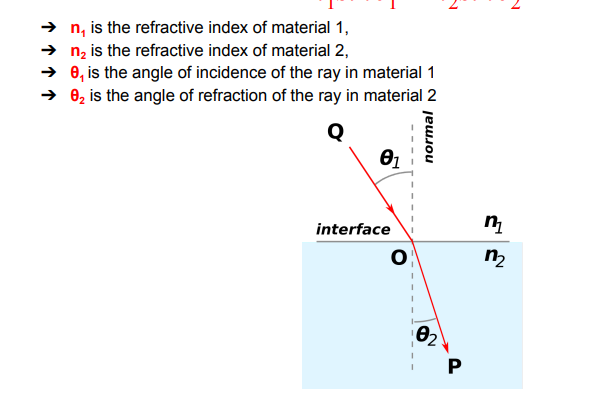
Critical angle equation
sin C= 1/n where n>1
When does total internal reflection (TIR) occur
when the angle of incidence is greater than the critical angle and the incident refractive index (n1) is greater than the refractive index of the material at the boundary (n2)
Converging lens
these are curved outwards on both sides and cause parallel light rays to move closer together/ converge at a point
Diverging
these are curved inwards on both sides and cause parallel light rays to move apart/diverge
Principle focus (F) in a converging lens
the point at which the light rays which are parallel to the principle axis are focused
Principle focus (F) in a diverging lens
the point from which the light rays appear to come from
Focal length (f)
the distance from the centre of the lens to the principle focus
Power
the measure of a lens’ ability to bend light. In converging lenses this value is positive and in diverging lenses this value is negative
Power equation
Power = 1/f
What is a thin lens
a lens with a thickness which allows rays to light to refract but not experience dispersion or aberrations
Real image
one which can be projected onto screen as light rays reach the image location
Virtual image
one that cannot be projected onto a screen